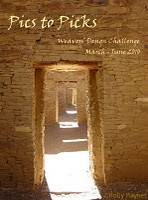There are some things of which you can never have enough. For a while, it had been fabric. I once saw a sign in a fabric shop that said "She who dies with the most fabric wins." Since I took up weaving, it has been weaving equipment and yarn.
We went to Nagoya, Japan for a family holiday. My mum and I caught the Shinkensan from Nagoya to Kyoto for the day to visit Avril and this other shop. Now who can go to Japan and not make the effort to get there especially when they have this!
We went to the main office/shop in Kyoto and just like the middle picture. There were just shelves of yarn. It was like a supermarket of yarn - room after room piled high. I also met the lady who looks after all the email orders. It is nice to have a real-life connection. I didn't really go crazy but you do have to make the most of the opportunity. As the website suggested, I did the research beforehand and got an order together with some of my friends. Yes, there is more than 3 kg of yarn in this photo and we spent 4 hours there.
 From left to right: silk/stainless steel core, cotton paper, washi linen with cotton cores, fine linen (grey) and bamboo.
From left to right: silk/stainless steel core, cotton paper, washi linen with cotton cores, fine linen (grey) and bamboo.

From left to right: natural dyed cashmere (mum is a knitter and the cashmere belongs in her stash), wool/silk mix (white)

Close up of the cotton paper yarn. Yarn from Pine fibre (white cone).
From top to bottom: merino wool/stainless steel core, silk/stainless steel core (black and pale grey)
I don't think there is a name in English for the weaving supply shop. It was in an older area of Kyoto and the shop owner spoke limited English. I got by with pointing (politely of course), very limited amount of japanese and the ability to read kanji from the price list. We were there for more than an hour, looking at different types of boat shuttles: apparently, there are different shapes for use with cotton, silk, wool, etc.

From top to bottom (in pairs): all purpose boat shuttles (with rollers and these beautiful copper tips. The tips are not weighted as fly shuttles. I think that they are there to protect the ends.), medium size shuttle suitable for pick up, small size shuttle for pick up. Note that there is a small hole on one side and a slot on the other of each shuttle. The small round hole is for fine silk and the slot is for thicker yarn.
I think that I will not have to buy yarn for a while now. (You have yet to see what I got when Edith (from Cloth Haven) took me to the wholesale places in Hong Kong! ) It will take me a long time to use up all this yarn. I am hoping that my yarn will not go the same 'obese' way as my fabric stash. My output needs to catch up with the input, and I am a slow weaver......
 I only have 2 claw weights that came with the machine but found what I think is a cast on comb? The cotton section is so delicate that it needed an even weight across the width of the whole piece. even then, I couldn't knit more than 15 full passes without it jumping off the needles.
I only have 2 claw weights that came with the machine but found what I think is a cast on comb? The cotton section is so delicate that it needed an even weight across the width of the whole piece. even then, I couldn't knit more than 15 full passes without it jumping off the needles.
















.jpg)


































.jpg)